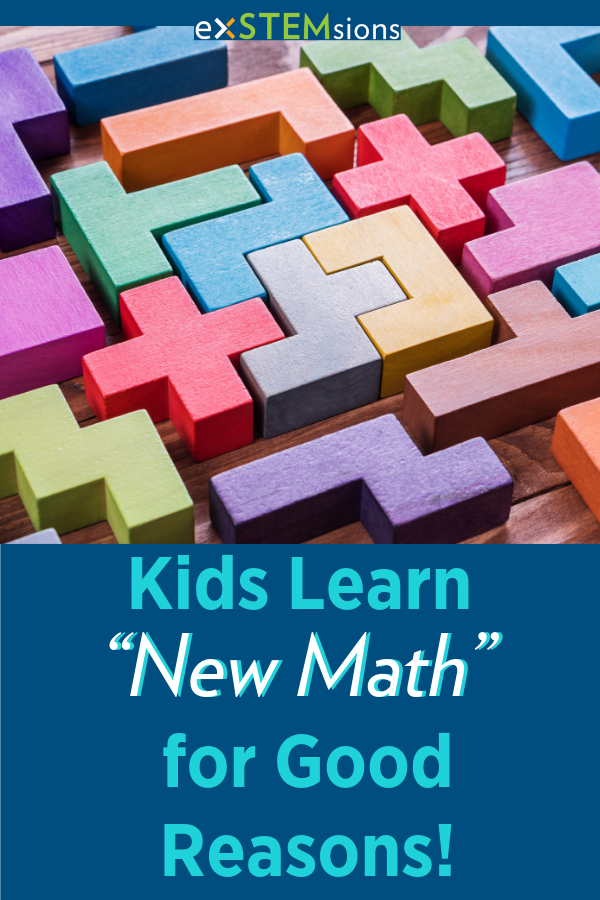Kids Learn “New Math” for Good Reasons

“That’s not the way I learned math!”
My friends and family know that I am a math teacher. It’s not a secret. And since it’s not a secret, I am the one they turn to when they are frustrated with the way math is being presented to their kids, or when their kids come home with math homework that they’re not sure how to make sense of. It sounds a lot like “What IS this? Why on earth does this need to be different? I’m an adult with a job, I turned out perfectly fine. Why can’t we just do it the old way?”
My response is always the same. Math today is taught differently for a good reason. Depending on your age, it likely should have been taught differently when you were in school - but it has taken the education world a long time to turn the boat, so to speak, towards newer, and more effective methods of learning math.
Yes, we all grew up and got jobs, and became productive citizens. I don’t argue that point at all. I get it. And I also know that it feels absolutely awful to have your child come home with work to do and not have the foggiest idea how to help them. I have been in that position too. But here’s the question I typically ask: how many adults do you know that really love math? How many adults do you know that are super comfortable with math, who don’t have anxiety when math sneaks up on them in daily tasks? Or who seek out opportunities to do math, just for fun? When I ask this question, the vast (and I do mean vast) majority of people don’t know many such adults. Maybe they can think of two or three people, but really, in most cases they just look at me funny.
The need for deeper learning in math
The goal of deeper learning is why math instruction is different today. We are a generation of adults who by and large learned math in a way that was not enjoyable, and that didn’t teach us how numbers work in a way that would lead to being able to work with numbers comfortably, flexibly, and happily. We mostly didn’t learn a variety of ways to approach any one kind of problem, so when we have to figure something out, and our go-to method doesn’t work, we’re often stuck. Of course, there are adults who came out of school thinking “Yay, math, get me more of that!” or who developed wonderful number sense. But many (if not most) of us didn’t. This is why math in school today for kids should be taught very differently from how us adults learned it. No matter where your kids learn math - in a classroom, in a homeschool, online, or in some combination thereof - today there is more emphasis than ever on learning about how and why numbers work the way they do. There is more emphasis on building number sense, and learning to solve problems in multiple ways. There is more emphasis on explaining thinking out loud, in pictures, and in writing, to help kids really make sense of the work they’re doing, and learn to communicate about math effectively.

More ways of doing math is a good thing!
I teach college students who are planning to become elementary school teachers. One of the topics we work on over the course of the semester is all the different methods there are for kids to do arithmetic. Every semester, every single one of my students is absolutely floored by the range of options, and almost all of them, at some point, say something like “Oh! This way makes so much more sense to me - I’m going to use this one all the time!” And this is a huge lesson for them to learn. They not only learn that there are multiple ways to add, subtract, multiply, or divide, but that each method brings something different to the table, and some ways make more sense to each of us than other ways. Seeing all the methods, comparing them, and then thinking about how it all fits together helps them, as college students, become better at math, but also helps them become teachers who naturally support a variety of solution methods in their future classrooms, and with their kids.
I want my kids to leave school knowing that they have the tools to solve any math problems that they might encounter. I want them to leave school understanding how numbers work, and being able to manipulate them easily, to do mental arithmetic, and to calculate efficiently. I want my kids to be comfortable and confident with math - not afraid, not hesitant. I want them to leave school feeling better about math than I did, or than you likely did. But in order for their feelings about, and comfort-level with, math to be different from the past, the way they are learning math has to be different than ours. We can’t expect our kids to learn math the same way that we did and somehow magically come out with a different result.
And yes, I get that appreciating new methods doesn’t fix the frustration that you might feel when your kids come home with math homework that seems unintelligible. When this happens, and it happens to me, just like it happens to you (and I’m a math teacher!), I find it useful to ask my kids a few particular questions about what they’re working on. I ask: “How did you do this with your teacher today?”, “How can we make sense of what’s here?” and/or “What do you know about how to do this?” Most of the time, my kids can give me enough information about what they’re doing and how they’re doing it to help us get rolling. And if they can’t, that’s not the end of the world (because we just had a math conversation!). I can email the teacher, and ask for some direction. I can use Google and their book to help me. But no matter how it works out, I try really, really hard not to revert to “Let me show you my way.” Not only do I not want to confuse my kids (for the sake of their teacher’s sanity), but I know, for sure, that they are learning math in a different way for a good reason. And if this is the path towards my kids coming out of school feeling good about math, I’ll do whatever I need to do to support that!
Find this post helpful? Follow the blog using the link at the top of the page to get notified when new posts appear!
Want amazing ways to doing math in different ways with your kids? Check out Mystery Equation in our TpT Store!



